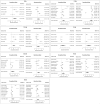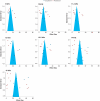Is Noise Exposure Associated With Impaired Extended High Frequency Hearing Despite a Normal Audiogram? A Systematic Review and Meta-Analysis
- PMID: 40375788
- PMCID: PMC12084714
- DOI: 10.1177/23312165251343757
Is Noise Exposure Associated With Impaired Extended High Frequency Hearing Despite a Normal Audiogram? A Systematic Review and Meta-Analysis
Abstract
Understanding the initial signature of noise-induced auditory damage remains a significant priority. Animal models suggest the cochlear base is particularly vulnerable to noise, raising the possibility that early-stage noise exposure could be linked to basal cochlear dysfunction, even when thresholds at 0.25-8 kHz are normal. To investigate this in humans, we conducted a meta-analysis following a systematic review, examining the association between noise exposure and hearing in frequencies from 9 to 20 kHz as a marker for basal cochlear dysfunction. Systematic review and meta-analysis followed PRISMA guidelines and the PICOS framework. Studies on noise exposure and hearing in the 9 to 20 kHz region in adults with clinically normal audiograms were included by searching five electronic databases (e.g., PubMed). Cohorts from 30 studies, comprising approximately 2,500 participants, were systematically reviewed. Meta-analysis was conducted on 23 studies using a random-effects model for occupational and recreational noise exposure. Analysis showed a significant positive association between occupational noise and hearing thresholds, with medium effect sizes at 9 and 11.2 kHz and large effect sizes at 10, 12, 14, and 16 kHz. However, the association with recreational noise was less consistent, with significant effects only at 12, 12.5, and 16 kHz. Egger's test indicated some publication bias, specifically at 10 kHz. Findings suggest thresholds above 8 kHz may indicate early noise exposure effects, even when lower-frequency (≤8 kHz) thresholds remain normal. Longitudinal studies incorporating noise dosimetry are crucial to establish causality and further support the clinical utility of extended high-frequency testing.
Keywords: extended high frequency; meta-analysis; noise exposure; noise-induced hearing loss; subclinical damage.
Conflict of interest statement
Declaration of Conflicting InterestsThe authors declared no potential conflicts of interest with respect to the research, authorship, and/or publication of this article.
Figures



Similar articles
-
Interventions to prevent occupational noise-induced hearing loss.Cochrane Database Syst Rev. 2017 Jul 7;7(7):CD006396. doi: 10.1002/14651858.CD006396.pub4. Cochrane Database Syst Rev. 2017. PMID: 28685503 Free PMC article.
-
Extended High-Frequency Thresholds: Associations With Demographic and Risk Factors, Cognitive Ability, and Hearing Outcomes in Middle-Aged and Older Adults.Ear Hear. 2024 Nov-Dec 01;45(6):1427-1443. doi: 10.1097/AUD.0000000000001531. Epub 2024 Jul 11. Ear Hear. 2024. PMID: 38987892 Free PMC article.
-
Hearing protection field attenuation estimation systems and associated training for reducing workers' exposure to noise.Cochrane Database Syst Rev. 2024 May 17;5(5):CD015066. doi: 10.1002/14651858.CD015066.pub2. Cochrane Database Syst Rev. 2024. PMID: 38757544 Free PMC article.
-
WHO Environmental Noise Guidelines for the European Region: A Systematic Review on Environmental Noise and Permanent Hearing Loss and Tinnitus.Int J Environ Res Public Health. 2017 Sep 27;14(10):1139. doi: 10.3390/ijerph14101139. Int J Environ Res Public Health. 2017. PMID: 28953238 Free PMC article.
-
Age-Related Decline in Neural Phase-Locking to Envelope and Temporal Fine Structure Revealed by Frequency Following Responses: A Potential Signature of Cochlear Synaptopathy Impairing Speech Intelligibility.J Assoc Res Otolaryngol. 2025 Jun;26(3):249-270. doi: 10.1007/s10162-025-00985-2. Epub 2025 Apr 21. J Assoc Res Otolaryngol. 2025. PMID: 40259175
References
-
- Amir Houshang M., Ali F., Mohammad Javad Zare S., Mohammad Hossein D. (2018). The efficacy of extended high-frequency audiometry in early detection of noise-induced hearing loss: A systematic review and meta-analysis. International Journal of Occupational Hygiene, 10(4), 250–264. https://ijoh.tums.ac.ir/index.php/ijoh/article/view/390
-
- Basiouny E. M., Shafei R. R. E., Ghannoum H. (2022). Assessment of hidden hearing loss in noise exposed workers. International Journal of Advanced Research, 10, 310–323. https://doi.org/doi.org/10.21474/IJAR01/15841
Publication types
MeSH terms
LinkOut - more resources
Full Text Sources
Medical

